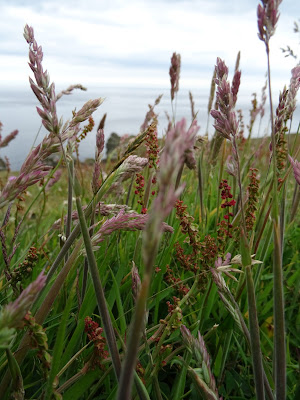Lots of splashes of yellow about; some with be bird's foot trefoil, which you can find in lots of different areas on the reserve. Thick carpet is on the clifftops at Foul Bay, you can see a blush of thrift (which is past its best) in the background. Bird's foot trefoil is a pretty common plant, but is rather beautiful with its splashed of red from which its alternative name of bacon-and-eggs arises.
Its really worth checking out any splashes of yellow you see on the reserve, because a lot of it will be this wee beauty at this time of year. Called the common rock rose, its actually not at all common, and its one plant that we take great care to manage the grasslands in favour of. Because it is a scarce plant in its own right, but also because it is the food plant of the caterpillar of the nationally scarce Northern brown argus butterfly. This picture was taken on the south facing side of Kirk Hill.
On similar well drained slopes you may come across carpets of purpley-pink plants, Wild Thyme. With their beautiful aroma when crushed they are a wonderful feature of the Head. Also common for the Northern brown argus, as they provide a nectar source for the adults. The yellow plant in the bottom right hand corner of this picture is ladies bedstraw, another flower you will see a lot of at this time of year.
Often mixed in with the wild thyme you may find this exquisite little flower, eyebright. This plant grows in lots of habitats from lowland moors to mountain tops and survives by being a semi-parasite - attaching its roots to and stealing nutrients from the roots of other plants. It gets its name from the fact that the flower looks like an eye, and in days gone by it was also thought to have medicinal properties for the eyes.
In the shorter grassland at the top of the cliffs you will also see patches of low growing white plants. These will most likely be heath bedstraw, a close relative to cleavers or sticky willy. You will find this in most grasslands that are not overgrazed.
In some areas of the reserve there is taller vegetation, much of which is a mixture of different varieties of grassland and also common sorrel. The sorrel's red flowers give these areas of the headland an orangy red hue at this time of year. In Tudor times common sorrel used to very prized for its sour taste, which was used in cooking very much like lemon is today.
Not all plants are so abundant and easy to spot from afar. This fluffy plant, Hare's-foot, clover, takes a little more finding. It likes to grow in sandy and rocky places, I came across this one at Horsecastle Bay. Its a plant that scarce in Berwickshire.
The wildlflowers of St Abb's Head are not only valuable for nature conservation reasons, they are also the icing on the cake - carpeting the stunning landscape with colour.
Enjoy!
Liza.








No comments:
Post a Comment